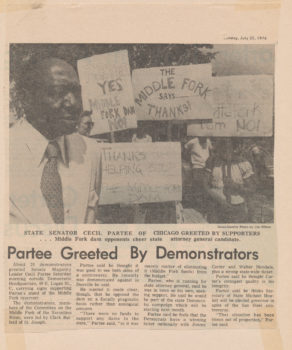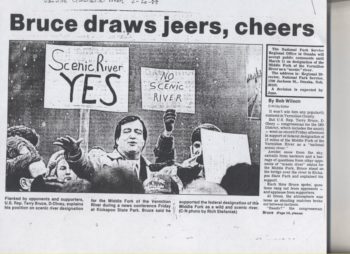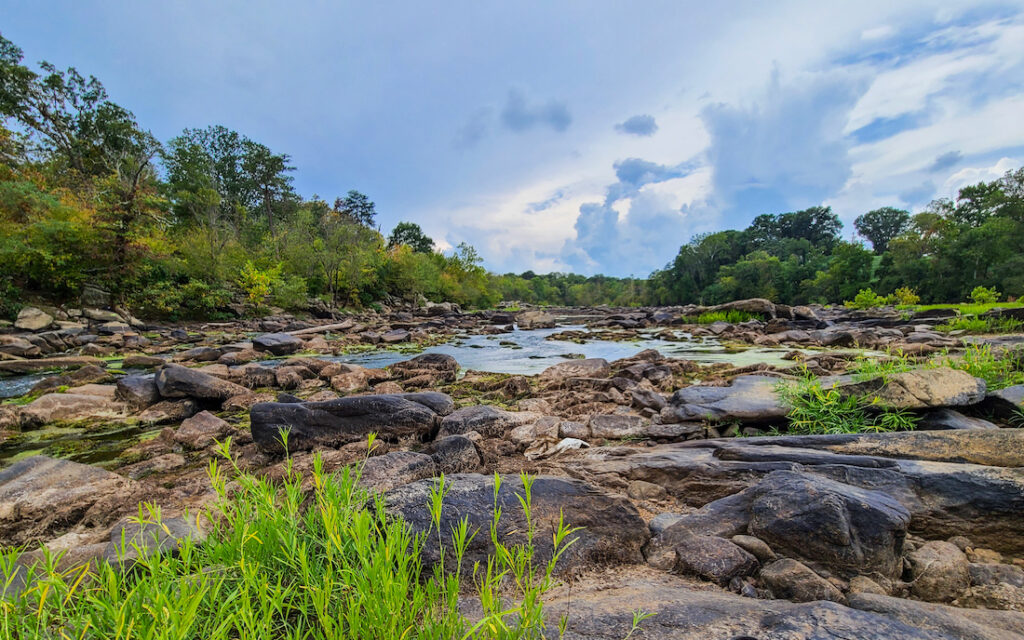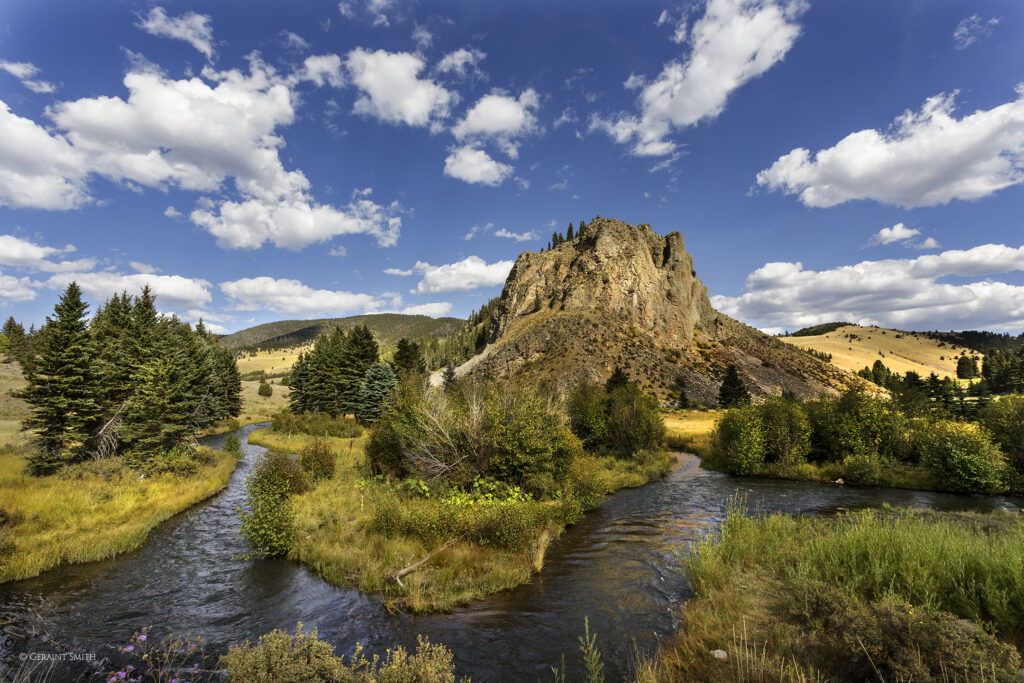Another Battle Wages Over Middle Fork Vermilion River
Illinois' endangered Middle Fork of the Vermilion River has a history of community activism against river threats and it sadly needs help again.
The following guest blog by Clark Bullard is part of our America’s Most Endangered Rivers® series on the Middle Fork of the Vermilion River in Illinois.
What? One of America’s National Scenic Rivers is on this year’s top 10 list of America’s Most Endangered Rivers®? That’s not supposed to happen.
 The Middle Fork of the Vermilion River is an oasis of natural beauty and ecosystem health in the middle of North America’s Great Corn and Bean Desert. Thirty years after being rescued from the dam builders, this treasured river ecosystem is now threatened by three million cubic yards of coal ash, dumped 40 feet deep adjacent to the riverbank behind a long-abandoned power plant. The dump is owned by Dynegy, which emerged from bankruptcy a few years ago and prefers the “cap and run” approach to shedding its responsibility for the arsenic and other toxins that are oozing orange leachate out of their unlined ash dumps.
The Middle Fork of the Vermilion River is an oasis of natural beauty and ecosystem health in the middle of North America’s Great Corn and Bean Desert. Thirty years after being rescued from the dam builders, this treasured river ecosystem is now threatened by three million cubic yards of coal ash, dumped 40 feet deep adjacent to the riverbank behind a long-abandoned power plant. The dump is owned by Dynegy, which emerged from bankruptcy a few years ago and prefers the “cap and run” approach to shedding its responsibility for the arsenic and other toxins that are oozing orange leachate out of their unlined ash dumps.
The lesson here is simple: laws and regulations alone do not protect rivers, people do.
In the 1960s, 1970s and 1980s, a massive 22-year nonpartisan all volunteer grassroots campaign was waged to stop a dam project that would have flooded the Middle Fork valley; this fight ultimately led to the Middle Fork of the Vermilion’s National Scenic River designation. For the first 10 years, 10,000 acres of land were bought while the project inched forward, construction appropriations were defeated, and studies were conducted. Then in 1976, 60,000 petition signatures were collected the old-fashioned way, representing every county in the state. A bipartisan collection of state legislators who received 10,000 handwritten letters from their constituents believed that facts mattered, and were impressed by facts about one of Illinois’ best aquatic ecosystems. The dam project was stopped.
Environmental victories are always temporary, but losses are permanent. The Middle Fork is no exception. A dozen years after the dam project was defeated, the Middle Fork of the Vermilion River was designated as a state scenic river, and the Illinois state legislature directed the Governor to apply for National Scenic River status to ensure that the river remained free-flowing.
 The National Park Service’s endorsement of the National Scenic River designation was the strongest to date on the river’s “outstandingly remarkable values” in all 6 categories: scenic, recreational, geologic, fish and wildlife, historic and archaeological. However, die-hard reservoir proponents lobbied President Ronald Reagan’s lame duck Interior Department Secretary, who rejected the National Park Service’s recommendation and denied Illinois’ request. Again, the statewide citizens group wasted no time persuading the state’s bipartisan congressional delegation to co-sign a letter to be carried by the Republican Governor to President Bush’s newly-appointed Interior Department Secretary. It worked. Since 1989, the Middle Fork of the Vermilion River has been safe from dam projects, but remains vulnerable to other risks.
The National Park Service’s endorsement of the National Scenic River designation was the strongest to date on the river’s “outstandingly remarkable values” in all 6 categories: scenic, recreational, geologic, fish and wildlife, historic and archaeological. However, die-hard reservoir proponents lobbied President Ronald Reagan’s lame duck Interior Department Secretary, who rejected the National Park Service’s recommendation and denied Illinois’ request. Again, the statewide citizens group wasted no time persuading the state’s bipartisan congressional delegation to co-sign a letter to be carried by the Republican Governor to President Bush’s newly-appointed Interior Department Secretary. It worked. Since 1989, the Middle Fork of the Vermilion River has been safe from dam projects, but remains vulnerable to other risks.
Now, 55 years’ worth of toxic coal ash remain where they were dumped on the river bank – an ugly but localized scar along a 17-mile stretch of otherwise public land. Rivers own their floodplains, so it is only a matter of time before a catastrophic failure of the ‘ash dam’ carries toxins an unpredictable distance downriver, harming people and wildlife along the way.
Dynegy needs to stop polluting the Middle Fork with their coal ash and take responsibility for the waste they’ve dumped next to the river. Future generations of taxpayers shouldn’t have to cover for Dynegy’s negligence.
Dynegy is being sued for violating the Clean Water Act by Prairie Rivers Network, which was formed in the late 1960s to stop dam projects throughout the Midwest, including this one. As that generation of founders and activists passes the baton to a new generation, we take this opportunity to express our gratitude again to the staff of American Rivers, who provided inspiration and valuable advice during our campaign to secure the National Scenic River designation 30 years ago. We can only hope that the next generation of activists remembers the words of David Brower: “This generation will decide if something untrammeled and free remains, as testimony that we had love for those who follow.”
TAKE ACTION TODAY!
[su_button url=”https://act.americanrivers.org/page/4946/action/1″ background=”#ef8c2d” size=”4″ center=”yes”]Take Action »[/su_button]
Clark Bullard was one of the first board members of the coalition that became Prairie Rivers Network.




